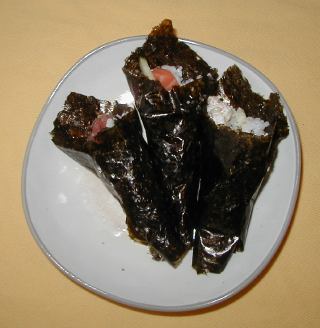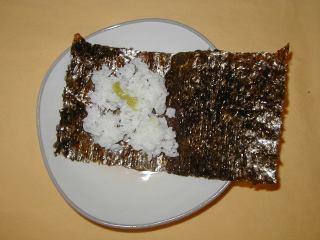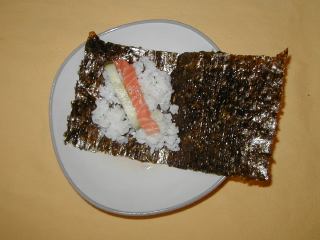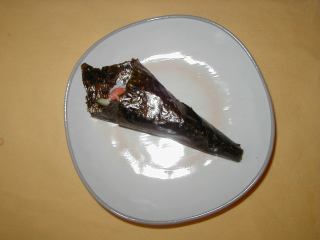
Sorry, this page content is available only in English
Temaki-sushi
(Hand rolled sushi)

1.
Introduction
Originally, sushi meant vinegared rice, and there are many type of
sushi in Japan. Usually, Nigiri-sushi, a rice ball with a piece of
fish on top, is served at Japanese restaurants. Maki-sushi, a sushi
roll, is also very common. However, Temaki-sushi (hand-rolled sushi)
is very popular at home, because it is much easier to prepare.
Temaki-sushi looks like a cone, surrounded by a sheet of Nori with
various Neta in the middle. Usually, rice, Nori and Neta is served on
the table, and everybody will roll it by oneself.
Talking of table manner, eating sushi by hand is an authentic way.
Usually, a small starter is served in the beginning, and then sushi
is served. Sashimi, just the fish on top of sushi, may be served
between the starter and sushi. In Japan, miso soup is served after
sushi. For drink, Sake, beer and Japanese green tea is recommended. I
personally like drinking dry white wine, e.g. Spanish Chardonnay and
French Chabris.
2.
Materials
A. Rice
There are two kind of rice, called Japonica and Indica.
Japonica is round short grain and becomes sticky after being
cooked. Indica is long grain like "Jasmine Rice" and is less
sticky than Japonica. Japonica is suited for sushi and
other Japanese dishes. Indica is suited for fried rice and
curry.
B. Japanese Vinegar
Japanese Vinegar is made from rice. You can buy it at Japanese food
shops and other places, but for home use, a special vinegar mix for
sushi such as "sushi seasoning" or freeze dried powder such as
"sushi-no-ko" is more easy and convenient. These products also
contains sugar and Japanese bouillon made from kombu.
C. Kombu
Kombu is a kind of kelp that grows in cold sea water in northern
coast of Japan. This is very widely used in Japanese cooking as a
source of buyon. For making sushi, a piece of kombu is cooked
together with the rice to give better flavor to it.
D. Nori
This is also a kind of sea weed, or algae. This is farmed in a quiet,
shallow water in the southern coast of Japan. This is usually dried
in frames and sold like sheets of black paper. For Temaki-sushi, we
usually cut it into approximately 10 cm square.
E. Wasabi
A very strong green paste. A kind of horseradish . This is used to
kill "fishy" smell, but also believed to prevent possible infection.
You can buy it as paste in a tube, or dried powder that needs to be
reversed into paste with water. Paste in a tube is more convenient,
but powder is usually cheaper.
F. Gari
Pickled ginger. Used for refreshing your mouth between different kind
of sushi.
G. Soy sauce
A Japanese company "Kikkoman" is making soy sauce in Europe, and this
can be easily found in Sweden.
H. Neta
Neta refers to topping or filling of sushi. Fish, sea foods,
vegetable and egg omelet are used, but can be anything of your
favorite thing. Most of the these Neta are fresh, but some of them
are served after marinated, cooked, steamed or grilled. From the
sanitary point of view, Neta must be very fresh and carefully
handled. It is very important to confirm the fish shop whether it is
suited for eating as sushi, however the safe and easy alternative is
to buy frozen products at Japanese food shop. Freezing the fish meat
is recommended to avoid possible worm infection, but some Neta is
safe and taste better without freezing. The typical Neta available in
Europe are following.
Tuna: The king of fish, the king of sushi. The pink, fat-rich meat is
called "Toro". Tuna is caught usually in Mediterranean or Atlantic
ocean, and usually already frozen during transportation.
Marlin (sword fish): Taste like tuna, but the meat looks more white
than tuna.
Salmon: Norwegian salmon is very good for sushi. In general, wild
salmon has high risk of worm infection without freezing. However,
most of Norwegian salmon is farmed and seems to be safe without
freezing in most of case. But for those who prefer safer side, frozen
salmon filet is recommendable.
Caviar: Various kind of caviar is suitable for sushi. Salmon caviar
is one of the best, but others are also good for sushi.
Eel: You can buy "Kabayaki", steamed and grilled eel, at Japanese
food shops. They are usually frozen and ready to go by just
warming.
Prawn: Frozen prawn that is already boiled and cut for sushi can be
found at Japanese food shops.
Shrimp: Boiled shrimp commonly found in Scandinavia is also good for
sushi. Can be combined with cucumber.
Scallop: Scallop is the most recommendable shell fish for sushi
available in Sweden. Must be very fresh or frozen. Can be combined
with cucumber.
Cucumber: A classic. Japanese cucumber is smaller, but this does not
matter.
Umeboshi: Pickled Japanese plum. You can buy as a whole or in the
form of paste at Japanese food shops. Goes very well with
cucumber.
Avocado: Serving avocado with tuna first became popular in
California, but now also popular in Japan.
Natto: Fermented soy bean. Served with soy sauce and Japanese
mustered. An equivalent to "blue cheese" in Japan; some love it,
others hate it.
Egg Omelet: Hard cooked omelet is also very popular. Usually Japanese
bouillon and sugar are added.
3.
Method
Step 1. Cooking rice
In Japan, we add 100 to 110 % vol/vol of water to washed rice when
cooking it. However, due to the dry climate in Sweden, it is
recommended to add 120 to 130 % vol/vol water. Soaking the rice in
water for one hour is also good to rehydrate the grain. Usually, 100
to 200 ml of rice is enough for one person, but depends on how hungry
he or she is.
Electric rice cooker is very convenient and gives stable results.
This is available from approximately SEK 600:-. However, you can also
cook it on normal electric stove. In that case, first with 2/6 power
for 10 minuets, then 6/6 power until the water is gone, and let it
sit for 15 minuets. Important thing is to avoid opening the lid of
the pan during the process, and observe the final incubation time.
When the water is gone, the boiling sound disappears, and this can be
also confirmed by touching the pot with hard thing.
A sheet of Kombu is added together with rice and water, but this can
be omitted when using powder vinegar.
Step 2. Adding vinegar and cooling
After the rice is cooked, then move it into a new bowl. Mix sushi
vinegar either in the form of liquid or powder. The recipe for sushi
vinegar is as following.
For 4 cup of rice (1 cup= 180 ml), use 1/2 cup of Japanese vinegar+ 5
Tbsp of sugar + 1 tsp of salt
In case of powder ("sushi-no-ko"), use 1 pack (75g) of it with 5 to 7
cup of rice.
Be careful not to destroy the rice grain. Let it cool down while
mixing. Then, the rice is ready.
Step 3. Preparing Neta
For Temaki-sushi, usually Neta will be prepared like a stick of 1 cm
x 1 cm x 10 cm. But this doesn't matter so far as it can be
rolled.
Step 4. Rolling at table
First, take a Nori-sheet on your palm.
Second, spread rice and Wasabi on it.

Third, put Neta.

Then, roll it like a cone.

Dip it to soy sauce just before
eating.
That's all!
4. Practical
information
Japanese food shops in Stockholm
1. Japan
Food and Kitchen (JFK): St
Eriksgatan 99, Tel. 08-34 38 15
2. Naoi: Tegnergatan 6, Tel. 08-673 58 81
3. San-Ai: Tegnergatan 15, Tel. 08-20 25 72
Suggestion of where to buy fresh
fish in Stockholm
1. Hörtorget Saluhall
2. Östermalms Saluhall
3. COOP at Fitja
4. ICA at Kungenskurva
Suggestion of Sushi bars in
Stockholm
1. MARU: Västmannagatan 69, Tel. 08-34 69 54
2. KI-MAMA: Observatoriegatan 13, Tel. 08-33 34 82
3. Roppongi: Hantverkargatan 76c, TEL: 08-650 17 72
Copyright (C) 2002, Takashi
Murata, All rights reserved